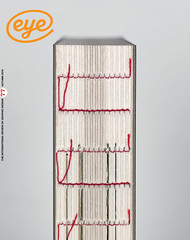Autumn 2010
Club-wielding poster boy
Victore, or Who Died and Made You Boss?
By James Victore Abrams, £24.99‘American Badass’, ‘Totally Live, Totally Nude’, and ‘Follow Your Damn Bliss’ are some of the titles James Victore considered for his monograph before settling on Who Died and Made You Boss?. The rejected titles are blasted across the hardback’s case in 60-point bold struck-through Helvetica – a self-revelatory gesture typical of this no-holds-barred artist and designer. Another list starts up after the title page: dripping down the page are the names of dozens of artists, poets, musicians, actors, directors, designers and politicians, who one supposes have helped shape Victore’s work. From Ovid and John Cage to Freddie Mercury and the Sumerians (‘for inventing beer’), they represent a broad, if largely male, spectrum of cultural practice and include few of the design greats usually name-checked in a contemporary designer’s monograph. This may have something to do with the fact that Victore is self-taught and didn’t go through the same Modernist education as many of his peers.
The story of Victore’s journey from a kid who leafed through poster annuals in the university library where his mum worked to becoming a designer in New York with work in MoMA’s collection and solo shows at Vitra is compelling. Victore has done things that many of us only dream about – quitting art school, cold-calling designers he respects, drawing pictures of humping bunnies for a living, painting on a nude model for the cover of Esquire, and firing clients whenever he feels like it.
His story is told in the first person, in roughly chronological extended captions that accompany the 48 projects selected for the book. These include book jackets, greeting cards, magazine covers, plates and surfboards, but the poster is clearly Victore’s preferred medium. He compares its power to that of ‘a large spiked club’, and his often feature violent or sexual material.
A powerful example is the pair of silk-screened posters titled ‘Disney Go Home’ and ‘Just Say No’, which he hung throughout Times Square in 1999 to protest against the Disneyfication of the district. The posters depict the silhouette of a decapitated Mickey, ink splats representing the blood spurting from his neck and his putrid green tongue hanging out.
The book design that frames this explosive material is sober. Paul Sahre has reversed the Helvetica type in white out of black; the only real nod to his subject’s contrariness is that the text runs vertically across the spreads, so you have to turn the book sideways to read it.
Both in their visceral style and their support of political causes, Victore’s posters continue the work of European artists such as Henryk Tomaszewski and Pierre Bernard. But he is doing this in America, where politicised posters – even for cultural institutions – must duke it out with Calvin Klein on illegal hoardings, overseen by mafia-run poster-hanging companies. Consider this, and the fact he has made a career out of designing posters is astonishing. The story of how he has done so is intriguing enough to sustain your interest until the last page.
First published in Eye no. 77 vol. 20 2010
Eye is the world’s most beautiful and collectable graphic design journal, published quarterly for professional designers, students and anyone interested in critical, informed writing about graphic design and visual culture. It is available from all good design bookshops and online at the Eye shop, where you can buy subscriptions and single issues.

